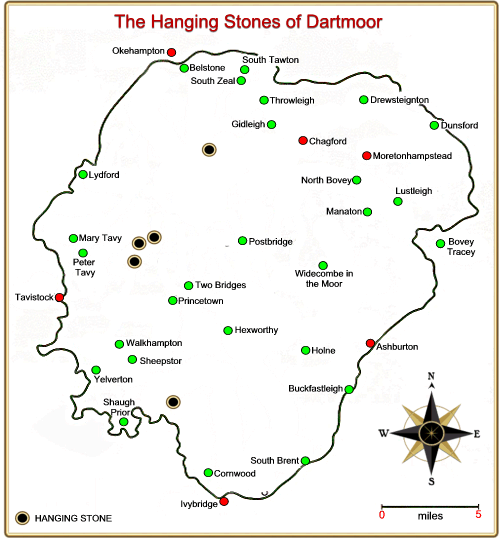
The legend of the Lee Moor Hangingstone has already been told on this website, but in fact there are four other so named rocks to be found on Dartmoor. It is thought that in the whole of the Devon there are nine such stones with similar legends attached to them and five of these are to be found on Dartmoor. The general gist of the legend is that a man is carrying a stolen sheep over his shoulder, the feet of the animal had been tied to ease transportation. He rests at a rock and the sheep struggles to escape which results in the rope which is tethering the animal gets wrapped around his neck and he hangs himself – hence the ‘hangingstone’. Before looking further into the whys and wherefores of the tradition it will be as well to see where the Dartmoor examples are located. As can be seen from the map below all are near centres of population.

There is a cluster centred around Tavistock and an isolated occurrence near Plymouth and another near Okehampton. There are various debates as to some of the main cluster being on various boundary lines, the earliest being 1280 which would suggest that the tradition has been around for some time. The middle rock of the main cluster served as an initiation point for young lads attending their first drift and it also acted as a reminder of the hangingstone tradition. For here a halter would be placed around the unfortunate boy’s neck and attached to the overhang. This left the boy suspended with just his feet touching the slope below. He would then be left there until the next day when the older moormen would return and release him. Miraculously there are no records of anyone dying from this Moorman’s initiation (Brewer, 2002, p.292).
But the big question is, why did such a tradition come into being in the first place? Grinsell (1985, p.217) considers that there is a sociological background to these stories which reflects the importance of sheep farming over the centuries. Clearly, Dartmoor has always been an important sheep rearing area and where you have sheep you will get those who want to steal them. There is a record from 1665 which lists the prisoners languishing in Exeter prison which notes one Henry Mortymer who was, ‘Committed by Rowland Whiddon esq charged for felonious takeinge and stealing of one sheepe the goods of Andrew Battishill gent’. Sheep stealing has to this day been a common practice in this country, so much so that in 1741 a law entitled, ‘An Act to render the Laws more effective for the preventing the stealing and destroying of Sheep‘ was passed. This specifically designated the death penalty for the offence of sheep stealing and across the country it was often meted out. In 1825 and 1831, out of a total of 9316 death sentences passed in Britain, 1039 were for sheep-stealing. In 1818 two men recieved the death sentence for stealing 5 sheep at the July sessions on the Western Circuit. At the time the judge added the following: ‘the offence had become so general, not only in this county, but in other counties, that it was the determination of those whose lot the administration of the laws fell, to make public examples of offenders of this description.’ (The Times, July 21st 1818). In 1830 two men, William Labsley and George Morrish were given the death penalty for sheep stealing at the Exeter Assizes, and these are but a few of the many examples to be quoted. They do however show the prevalence of the crime and the serious punishments dished out for those unfortunate enough to get caught. So it could be assumed that the tradition of the sheep stealer’s demise came about as a warning to those contemplating such a crime. The only problem with this is that out of the five examples of hanging stones on Dartmoor it is only the southern one that has the legend attached to it. The northern example on Hangingstone Hill is thought to have derived its name not from the tradition but from the fact that it was a logan stone that appeared to ‘hang’ on a pivot and could be rocked (Hemery, p.1983, p.823). In some of the other instances across Britain the hanging stones are located on parish boundaries and are associated with nearby gallows. It is here that criminals, including sheep stealers would be hung, thus word spread of the association of large rocks and hangings (Grinsell, 1985, p.217). Again in the case of the Dartmoor cluster this theory does not work as neither of them were sites of gallows or gibbets despite being on parish boundaries. Could it be that the idea of them being hanging or logan stones apply? Quite simply, no, because the southern rock of the cluster is a single rounded boulder and the central one is a big split boulder with no sign of anything that would ‘log’. The northern rock of the cluster is the one where the old moorman’s initiation was carried out which did re-enact the tradition but again there is no record of a sheep stealer hanging himself here. So does the name refer to this custom as opposed to a folk story about a sheep stealer? Or could it be that all three instances of hanging stones in the Walkham valley are due to some confusion as to exactly which one was the original?
Reference.
Brewer, D. 2002. Dartmoor Boundary Markers. Tiverton: Halsgrove Publishing.
Grinsell, L. 1985. Hanging Stones and their Traditions. In Folklore, Vol. 96. Number 2. pp 217 – 222.
Hemery, E. 1983. High Dartmoor. London: Hale Publishing.
 Legendary Dartmoor The many aspects past and present of Dartmoor
Legendary Dartmoor The many aspects past and present of Dartmoor
